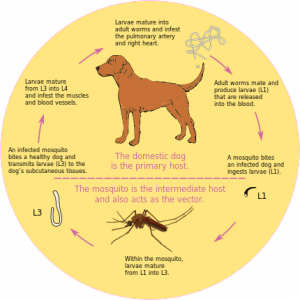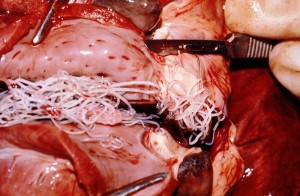For anyone who has managed to bypass the constant bombardment of love heart- themed everything- today is Valentine’s Day. On this day, scorned by singletons, we consider one of the true agents of heart ache- Dirofilaria immitis aka the heartworm.
 Caused by this parasitic, filarial nematode, dirofilariasis is a vector-borne zoonose affecting the cardiovascular and pulmonary systems. Although the parasite can infect several mammals including humans and cats, domestic and wild dogs are its main reservoir.
Caused by this parasitic, filarial nematode, dirofilariasis is a vector-borne zoonose affecting the cardiovascular and pulmonary systems. Although the parasite can infect several mammals including humans and cats, domestic and wild dogs are its main reservoir.
Culicidae mosquitoes including numerous Anopheline, Culex and Stegomyia species are the main vectors of D. immitis. During an infective mosquito bite, third-stage larvae (L3) penetrate the host’s skin where they then migrate to the pulmonary artery and right ventricle of the canine’s heart. Here they reach sexual maturity, with females reaching up to 35cm in length and males 20cm. The females release microfilariae (MF) into the systemic circulation, where they can be ingested by feeding mosquitoes. Larval stages in the vector host develop into infective L3 stages, migrating to the mouth parts where they complete transmission upon biting.
Canine dirofilariasis is prevalent across the world both in tropical and temperate climates. In dogs, the disease is characterised by the progressive deterioration of the cardiovascular system, quickly followed by pulmonary complications often resulting in haemorrhaging and cardiac failure. Antigens derived from larval/adult stages and endosymbiotic Wolbachia can also trigger different immune responses resulting in further complications such as renal dysfunction and eosinophilic pneumonia.
Human dirofilariasis is not as common as the canine disease and not as severe. In humans the development of infective larvae is arrested before maturity is reached. These larvae often become lodged in various locations in the body, triggering inflammatory responses resulting in nodules. Often this occurs in the lungs causing pulmonary dirofilariasis, which can be misdiagnosed as malignant lesions. However, these worms really can end up anywhere- most recently, a case was reported of D.immitis infection mimicking paratesticular malignancy. But often infections are asymptomatic, and it is generally only in co-infections with closely related D. repens that drastic complications arise. This is not uncommon due to the geographical overlap of D. immitis and D. repens in the Old World.
Diagnosis of canine dirofilariasis is made by microscopic examination of circulating MF using Knott’s test (centrifugation of blood) and by ELISA for circulating adult antigens. It is important to distinguish between D. immitis and D. repens infections in dogs as the macro/microfilaricides used for treatment of D. repens are unsuitable for dogs with cardiovascular damage as a result of D. immitis infections. A recently published technique uses RT-PCR coupled to high resolution melting analysis to help improve discrimination between the two species.
 Although, D. immitis is prevalent across the world and even endemic to many European countries, the vast majority of cases of human dirofilariasis caused by D. immitis occur in the New World. It seems that the prevalence of the nematode is far wider than originally thought and most likely still underestimated. The control of the disease is also becoming more complicated due to the wide range of competent mosquito species.
Although, D. immitis is prevalent across the world and even endemic to many European countries, the vast majority of cases of human dirofilariasis caused by D. immitis occur in the New World. It seems that the prevalence of the nematode is far wider than originally thought and most likely still underestimated. The control of the disease is also becoming more complicated due to the wide range of competent mosquito species.
Changing climate and environmental conditions, as well as globalisation in terms of travel and migration, often result in the introduction of new vector species. A recent study in the US found that factors such as vegetation, temperature and landscape had a significant impact on the risk of canine dirofilariasis.
It has also been suggested that this difference in manifestation could be due to the presence of a more virulent strain of D. immitis in the Americas. Indeed, recent investigations into a case of human dirofilariasis in the state of Pará (Brazil) revealed a morphologically and phylogenetically related nematode to D. Immitis that was found to be genetically distinct to other canine-infective D. immitis nematodes in the area. However, the genetics of the aetiology of human dirofilariasis are very poorly understood and further studies into the characterisation of these nematodes would be useful in the efforts to overcome this heart breaking disease.


Comments